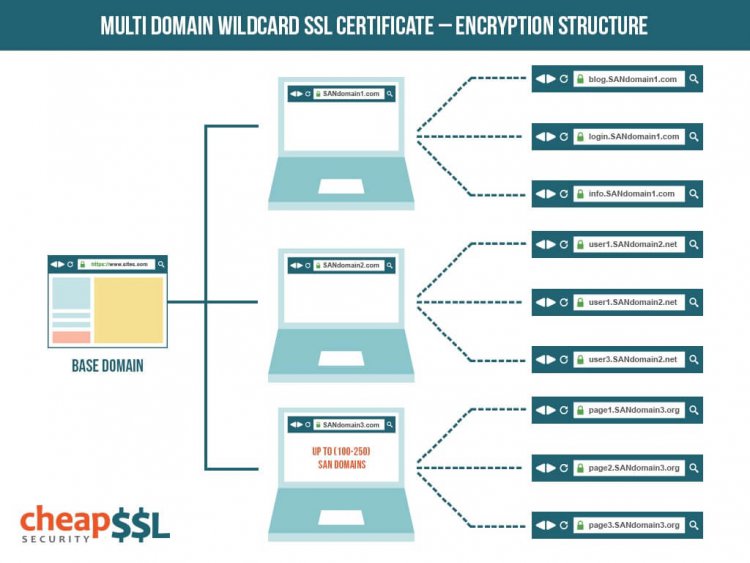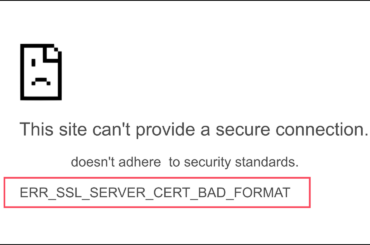In-depth guide on multi-level subdomain security, and the use cases for wildcard and multi-domain wildcard SSL certificates
Securing a single website with an SSL certificate is pretty simple. It can get complicated when you need to secure multiple websites across different subdomains, or across multiple levels of subdomains (for example: blog.domain.com and new.blog.domain.com).
Before we jump into analyzing more advanced scenarios let’s start with a short summary of standard wildcard SSL certificates and how they work.
What is a Wildcard Certificate?
A wildcard SSL certificate is the next-generation security solution that allows the main website and its subdomains to be secured by a single SSL certificate, even if the sites are on the multiple servers. It is a one-stop security solution for any website with multiple subdomains. It is a reliable and scalable certificate that unifies all subdomains security into singe certificate, saving money and making certificate management seamless.
Key benefits of a wildcard SSL certificate:
- It’s a cost-effective, unified solution for encrypting various subdomains on a single domain.
- It can add the latest encryption technology, with 256-bit strength encryption.
- It is supported by all modern browsers and mobile devices.
- It’s futureproof – any new subdomains you add will automatically be protected.
A wildcard SSL certificate encrypts unlimited subdomains on the same level. For example, a wildcard certificate for *.yourdomain.com will encrypt:
- blog.yourdomain.com
- mobile.yourdomain.com
- resource.yourdomain.com
- etc.
What About Multi-Level Subdomains?
But what if you want to encrypt the second-level subdomains? For example;
- dev.server.yourdomain.com
- server1.blog.yourdomain.com
- mail.server.yourdomain.com
Buy Wildcard SSL Certificate for Multiple Servers
Install a single Comodo Wildcard SSL and secure unlimited subdomains on the multiple servers. It takes a few minutes for issuance and installation.
Or even third level, such as blue.dev.server.yourdomain.com?
In this situation, you need another solution – you need a multi-domain wildcard SSL certificate.
What is a Multi-Domain Wildcard SSL Certificate?
A multi-domain wildcard SSL certificate is the perfect solution for situations where you need to secure multi-level subdomains. It allows encrypting multiple levels of subdomains with one certificate. Like the wildcard certificate, it can work whether the sites are on the same or separate servers.
Key benefits of a multi-domain wildcard SSL certificate:
- Can be used on multiple servers to handle the security of multiple domains.
- Significantly reduces the cost of website security.
- Supports the highest strength encryption: 256-bit encryption.
- Supported by all major web browsers and mobile devices.
- Flexible to cover up to 250 multiple subdomains and websites security.
- It reduces the complexity in an industry of SSL and empowers the layers of protection for small and wide-scale organizations.
Multi Domain Wildcard SSL – Secure Up to 250 Multiple Domains
We offer Multi Domain Wildcard SSL certificates from the most trusted SSL brands. It includes unlimited server license, re-issuance, FREE trust seal, and more.
As far as technical features such as encryption strength and browser support, there is no significant difference between standard wildcard and MDC wildcard certificate. The key difference is that the multi-domain wildcard certificate can be used to secure multiple levels of subdomains. Here’s how:
Securing Multi-Level Subdomains With a Multi-Domain Wildcard SSL Certificate
Let’s say you need to secure the following 14 subdomains:
- domain.com
- blog.domain.com
- preview.domain.com
- dev.domain.com
- dev.blog.domain.com
- dev.preview.domain.com
- project1.preview.domain.com
- project2.preview.domain.com
- project3.preview.domain.com
- project4.preview.domain.com
- dev.project1.preview.domain.com
- dev.project2.preview.domain.com
- dev.project3.preview.domain.com
- dev.project4.preview.domain.com
If you used a standard single domain SSL certificate, you’d need 14 separate SSL certificates. That’s a lot of hassle!
With a wildcard SSL certificate, the solution is a bit simpler. You can purchase 7 wildcard SSL certificates, to protect:
- *.domain.com
- *. blog.domain.com
- *.preview.domain.com
- *.project1.preview.domain.com
- *.project2.preview.domain.com
- *.project3.preview.domain.com
- *.project4.preview.domain.com
That’s still a lot of certificates to purchase and manage. A multi-domain wildcard SSL certificate allows you to purchase a single SSL certificate, and add the above 7 sites as SANs (subject alternative names) to the SSL certificate. This allows you to save a lot of money and hassle by purchasing and installing a single SSL certificate.
Bottom line: If you have multiple levels of subdomains, a multi-domain wildcard SSL certificate is your best option!
Other Related Resources
- Multi-Domain SSL – Comprehensive SSL Security for Business Websites
- The Difference between Wildcard & Multi-Domain (SAN) SSL Certificate
- Comodo UCC SSL to secure Microsoft Exchange & Office Communication Server
- Your HTTP Website will be Labeled ‘Not Secure’ from Today!
- Why EV SSL Certificates Are Perfect for Startup E-Commerce Companies
- EV SSL for Website Security: Financial Benefits of the Green Address Bar
- UCC Certificate vs Wildcard SSL — Which One is the Best Option?
- Free Multi Domain SSL Certificate — Is it Really Possible?
- What is UCC SSL? How Does It Protect 250 Multiple Domain Names





